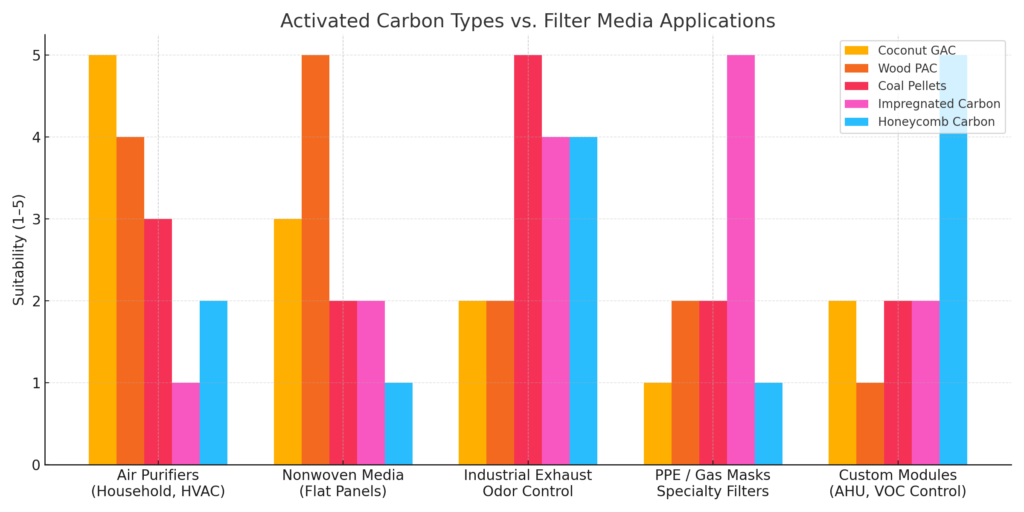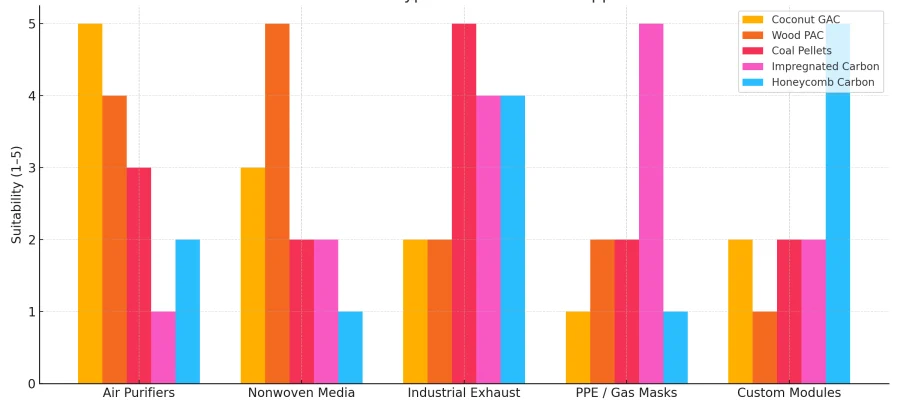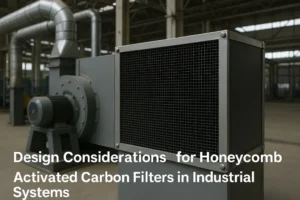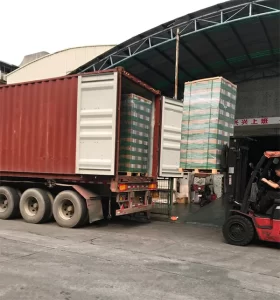Commercial filter media incorporating activated carbon is widely used for air purification, odor control, and VOC removal in applications ranging from HVAC systems to industrial gas treatment. But not all activated carbons are the same. The choice of carbon type directly affects the filter’s adsorption efficiency, pressure drop, and service life.
Activated Carbon Selection: Key Factors
As a professional activated carbon supplier, we help filtration manufacturers select the right carbon based on the following technical criteria:
- Raw material base (coconut shell, wood, bituminous coal, nutshell)
- Pore structure and distribution (micropores, mesopores, macropores)
- Granule or powder shape (mesh size, shaped or crushed)
- Target contaminants (VOCs, ozone, SO₂, aldehydes, odors)
- Physical form and integration (loose-fill, bonded, impregnated)
Common Activated Carbon Types in Filter Media
1. Coconut Shell-Based Granular Activated Carbon (GAC)
This is one of the most common choices for commercial and residential air filters. Coconut activated carbon features a high proportion of micropores, making it effective for low-molecular VOCs such as formaldehyde, benzene, and toluene. It offers:
- High hardness and low dust—ideal for loose-fill filters
- Excellent adsorption of airborne chemicals and odors
- Stable performance in dry or moderately humid conditions
2. Wood-Based Powdered Activated Carbon (PAC)
Wood-based PAC is used in composite filter media, including non-woven fiber mats impregnated or sprayed with carbon slurry. Due to its mesoporous structure, it offers fast adsorption kinetics and is well-suited for wide-spectrum odor control. Applications include:
- Flat panel filters for HVAC and cabin air systems
- Carbon-impregnated prefilters in room purifiers
- High surface area and lightweight designs
3. Coal-Based Activated Carbon Pellets
Bituminous coal-based carbon, often extruded into 3–4 mm pellets, is used in cylindrical cartridge filters and industrial filter beds. It provides a broader pore distribution and high volumetric capacity, making it effective for VOCs, sulfides, and acidic gases. Often used in:
- Gas phase filtration in electronics or cleanroom facilities
- Industrial exhaust treatment systems
- Odor control units for wastewater and composting plants
4. Impregnated or Catalytic Activated Carbon
For reactive gases (e.g., formaldehyde, ammonia, H₂S), carbons may be impregnated with acids, bases, or metal catalysts. These specialized grades are used in high-performance filters where standard physical adsorption is insufficient. Filter examples include:
- ABEK gas filters for personal protective equipment (PPE)
- Chemisorptive panels for hospital and laboratory use
- Formaldehyde removal filters in air purifiers
5. Honeycomb Activated Carbon
Honeycomb activated carbon is a structured form of carbon filter media, typically produced by molding or extrusion of carbon powder with binder materials into blocks or monolithic shapes. This format is widely used for large-volume gas treatment where low pressure drop and high contact efficiency are critical. It is often custom-manufactured to specific sizes and application requirements.
Common use cases include:
- VOC removal in commercial and industrial exhaust systems
- Air purification in parking garages, chemical warehouses, and public buildings
- Customized modules in air handling units (AHUs) and central ventilation systems
Honeycomb carbon is valued for its:
- High surface area-to-volume ratio
- Minimal airflow resistance
- Structural stability for long-term performance

Filter Media Integration Methods
Activated carbon can be incorporated into filter media in several forms:
- Loose-fill beds: used in V-bank or cartridge filters
- Bonded carbon sheets: foam or nonwoven substrates impregnated with PAC
- Honeycomb modules: made with carbon powder and binders for structured airflow
- Pleated composite media: combining fiber layers with carbon load
Conclusion
Choosing the right type of activated carbon for filter media depends on the application environment, target gases, and required filter design. As an experienced carbon supplier, HANYAN supports OEMs and filter manufacturers with customized carbon solutions, bulk supply, and technical matching services.
Contact us to discuss your filter application and receive a tailored activated carbon recommendation.
Article Keywords: activated carbon filter media, coconut activated carbon, wood-based PAC, wood activated carbon, coal carbon pellets, coal-based activated carbon, coal activated carbon, VOC filter, air purification carbon, carbon filter supplier, filter manufacturing




